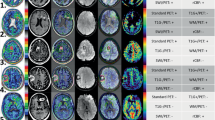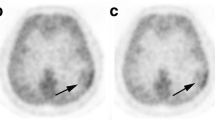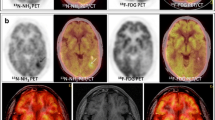Abstract
Purpose
Reliable differential diagnosis between tumour recurrence and treatment-induced lesions is required to take advantage of new therapeutic approaches to recurrent gliomas. Structural imaging methods offer a high sensitivity but a low specificity, which might be improved by neurofunctional imaging. This study aimed to test the hypothesis that incorporation of 18-fluoro-deoxy-glucose positron emission tomography (FDG-PET) increases the accuracy of this differential diagnosis obtained with 201Tl chloride-single-photon emission computed tomography (201Tl-SPECT).
Materials and methods
Seventy-six patients (mean age 47.72 ± 16.19 years) under suspicion of glioma recurrence, 42% with low-grade and 58% with high-grade lesions, were studied by 201Tl-SPECT and FDG-PET, reporting results under blinded conditions using visual analysis. Tumour was confirmed by histological confirmation (23 patients) or clinical and structural neuroimaging follow-up (mean of 2.6 years).
Results
This population had a high disease prevalence (72%). Globally, highest sensitivity was obtained using 201Tl-SPECT assessed with MRI (96%) and highest specificity using FDG-PET + MRI (95%). FDG-PET appeared slightly better for confirming tumour recurrence, whereas 201Tl-SPECT was superior for ruling out possible recurrence (disease present in 38% of FDG-PET negative explorations). In the high-grade subgroup, there were no false-positive examinations (specificity: 100%), but sensitivity differed among techniques (201Tl-SPECT: 94%; 201Tl-SPECT + MRI: 97%; FDG-PET + MRI: 83%). In the low-grade subgroup, 201Tl-SPECT+ MRI showed highest sensitivity (95%) and lowest posttest negative probability (9%); FDG-PET + MRI offered highest specificity (92%) with a posttest negative probability of 35%.
Conclusions
FDG-PET does not clearly improve the diagnostic accuracy of 201Tl-SPECT, which appears to be a more appropriate examination for the diagnosis of possible brain tumour recurrence, especially for ruling it out.


Similar content being viewed by others
References
Hoffman JM. New advances in brain tumour imaging. Curr Opin Oncol. 2001;13:148-53.
Cao Y, Sundgren PC, Tsien CI, Chenevert TT, Junck L. Physiologic and metabolic magnetic resonance imaging in gliomas. J Clin Oncol. 2006;24:1228-35.
Hollingworth W, Medina LS, Lenkinski RE, Shibata DK, Bernal B, Zurakowski D, et al. A systematic literature review of magnetic resonance spectroscopy for the characterization of brain tumours. AJNR Am J Neuroradiol. 2006;27:1404-11.
Ricci PE, Dungan DH. Imaging of low- and intermediate-grade gliomas. Semin Radiat Oncol. 2001;11:103-12.
Lang FF, Gilbert MR. Diffusely infiltrative low-grade gliomas in adults. J Clin Oncol. 2006;24:1236-45.
Benard F, Romsa J, Hustinx R. Imaging gliomas with positron emission tomography and single-photon emission computed tomography. Semin Nucl Med. 2003;33:148-62.
Sehweil AM, McKillop JH, Milroy R, Wilson R, Abdel-Dayem HM, Omar YT. Mechanism of 201Tl uptake in tumours. Eur J Nucl Med Mol Imaging. 1989;15:376-9.
Perry JR, Cairncross JG. Glioma therapies: how to tell which work? J Clin Oncol 2003;21:3547-9.
Minn H. PET and SPECT in low-grade glioma. Eur J Radiol. 2005;56:171-8.
Spaeth N, Wyss MT, Pahnke J, Biollaz G, Lutz A, Goepfert K, et al. Uptake of 18F-fluorocholine, 18F-fluoro-ethyl-l-tyrosine and 18F-fluoro-2-deoxyglucose in F98 gliomas in the rat. Eur J Nucl Med Mol Imaging. 2006;33:673-82.
Kahn D, Follett KA, Bushnell DL, Nathan MA, Piper JG, Madsen M, et al. Diagnosis of recurrent brain tumour: value of 201Tl SPECT vs. 18F-fluorodeoxyglucose PET. AJR Am J Roentgenol. 1994;163:1459-65.
Ricci PE, Karis JP, Heiserman JE, Fram EK, Bice AN, Drayer BP. Differentiating recurrent tumour from radiation necrosis: time for re-evaluation of positron emission tomography? AJNR Am J Neuroradiol. 1998;19:407-13.
Chao ST, Suh JH, Raja S, Lee SY, Barnett G. The sensitivity and specificity of FDG PET in distinguishing recurrent brain tumor from radionecrosis in patients treated with stereotactic radiosurgery. Int J Cancer. 2001;96:191-7.
Jacobs AH, Li H, Winkeler A, Hilker R, Knoess C, Rüger A, et al. PET-based molecular imaging in neuroscience. Eur J Nucl Med Mol Imaging. 2003;30:1051-65.
Vos MJ, Berkhof J, Postma TJ, Hoekstra OS, Barkhof F, Heimans JJ. Thallium-201 SPECT: the optimal prediction of response in glioma therapy. Eur J Nucl Med Mol Imaging. 2006;33:222-7.
Oriuchi N, Tomiyoshi K, Inoue T, Ahmad K, Sarwar M, Tokunaga M, et al. Independent thallium-201 accumulation and fluorine-18-fluorodeoxyglucose metabolism in glioma. J Nucl Med. 1996;37:457-62.
Sasaki M, Kuwabara Y, Yoshida T, Nakagawa M, Fukumura T, Mihara F, et al. A comparative study of thallium-201 SPET, carbon-11 methionine PET and fluorine-18 fluorodeoxyglucose PET for the differentiation of astrocytic tumours. Eur J Nucl Med Mol Imaging. 1998;25:1261-9.
Kleihues P, Louis DN, Scheithauer BW, Rorke LB, Reifenberger G, Burger PC, et al. The WHO classification of tumors of the nervous system. J Neuropathol Exp Neruol. 2002;61:215-25.
Mc Donald DR, Cascino TL, Schold SC Jr, Cairncross JG. Response criteria for Phase II studies of supratentorial malignant glioma. J Clin Oncol. 1990;8:1277-80.
Ortega S, Rodríguez-Fernández A, Martínez del Valle MD, Gómez R-M, Ramos-Font C, Sabatel G, et al. 201Tl-SPECT, FDG-PET and neurostructural imaging in the follow-up of glial brain tumours (Abstract). Eur J Nucl Med Mol Imaging. 2004;31:293-4.
Gomez-Río M, Martinez Del Valle Torres D, Rodriguez-Fernandez A, Llamas-Elvira JM, Lozano SO, Font CR, et al. 201Tl-SPECT in low-grade gliomas: diagnostic accuracy in differential diagnosis between tumour recurrence and radionecrosis. Eur J Nucl Med Mol Imaging. 2004;31:1237-43.
Mettler FA Jr, Guiberteau MJ. Essentials of nuclear medicine imaging. Chapter 4: cerebrovascular system. 5th ed. Philadelphia: Saunders-Elsevier; 2006. p. 53-74.
Kim CK, Alavi JB, Alavi A, Reivich M. New grading system of cerebral gliomas using positron emission tomography with F-18 fluorodeoxyglucose. J Neurooncol. 1991;10:85-91.
Meyer PT, Schreckenberger M, Spetzger U, Meyer GF, Sabri O, Setani KS, et al. Comparison of visual and ROI-based brain tumor grading using 18F-FDG PET: ROC analyses. Eur J Nucl Med Mol Imaging. 2001;28:165-74.
Vos MJ, Tony BN, Hoekstra OS, Postma TJ, Heimans JJ, Hooft L. Systematic review of the diagnostic accuracy of 201Tl single photon emission computed tomography in the detection of recurrent glioma. Nucl Med Commun. 2007;28:431-9.
Bryan RN. What’s your favourite PET story? Am J Neuroradiol. 1998;19:590.
Mineura K, Sasajima T, Kowada M, Ogawa T, Hatazawa J, Shishido F, et al. Perfusion and metabolism in predicting the survival of patients with cerebral gliomas. Cancer. 1994;73:2386-94.
Lammertsma AA, Wise RJ, Cox TC, Thomas DG, Jones T. Measurement of blood flow, oxygen utilisation, oxygen extraction ratio, and fractional blood volume in human brain tumours and surrounding oedematous tissue. Br J Radiol. 1985;58:725-34.
Chen W, Cloughesy T, Kamdar N, Satyamurthy N, Bergsneider M, Liau L, et al. Imaging proliferation in brain tumours with 18F-FLT PET: comparison with 18F-FDG. J Nucl Med. 2005;46:945-52.
Vos MJ, Uitdehaag BM, Barkhof F, Heimans JJ, Baayen HC, Boogerd W, et al. Interobserver variability in the radiological assessment of response to chemotherapy in glioma. Neurology. 2003;60:826-30.
Hustinx R, Pourdehnad M, Kaschten B, Alavi A. PET imaging for differentiating recurrent brain tumour from radiation necrosis. Radiol Clin N Am. 2005;43:35-47.
Goldman S, Levivier M, Pirotte B, Brucher JM, Wikler D, Damhaut P, et al. Regional glucose metabolism and histopathology of gliomas. A study based on positron emission tomography-guided stereotactic biopsy. Cancer 1996;78:1098-106.
Henze M, Mohammed A, Schlemmer HP, Herfarth KK, Hoffner S, Haufe S, et al. PET and SPECT for detection of tumour progression in irradiated low-grade astrocytoma: a receiver-operating-characteristic analysis. J Nucl Med. 2004;45:579-86.
Galanis E, Buckner JC. Chemotherapy of brain tumours. Curr Opin Neurol 2000;13:619-25.
Jackson RJ, Fuller GN, Abi-Said D, Lang FF, Gokaslan ZL, Shi WM, et al. Limitations of stereotactic biopsy in the initial management of gliomas. Neuro-Oncol. 2001;3:193-200.
Siepmann DB, Siegel A, Lewis PJ. Tl-201 SPECT and F-18 FDG PET for assessment of glioma recurrence versus radiation necrosis. Clin Nucl Med. 2005;30:199-200.
Belohlávek O, Simonová G, Kantorová I, Novotný J Jr, Liscák R. Brain metastases after stereotactic radiosurgery using the Leksell gamma knife: can FDG PET help to differentiate radionecrosis from tumour progression? Eur J Nucl Med Mol Imaging. 2003;30:96-100.
Matheja P, Rickert C, Weckesser M, Palkovic S, Lottgen J, Riemann B, et al. Sequential scintigraphic strategy for the differentiation of brain tumours. Eur J Nucl Med Mol Imaging. 2000;27:550-8.
Acknowledgments
The authors are grateful to Richard Davies for assistance with the English version and to Pablo Lardelli-Claret for study design and data analysis supervision.
Author information
Authors and Affiliations
Corresponding author
Rights and permissions
About this article
Cite this article
Gómez-Río, M., Rodríguez-Fernández, A., Ramos-Font, C. et al. Diagnostic accuracy of 201Thallium-SPECT and 18F-FDG-PET in the clinical assessment of glioma recurrence. Eur J Nucl Med Mol Imaging 35, 966–975 (2008). https://doi.org/10.1007/s00259-007-0661-5
Received:
Accepted:
Published:
Issue Date:
DOI: https://doi.org/10.1007/s00259-007-0661-5




